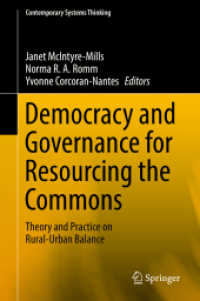基本説明
初版(1996年)の三倍の情報を提供する化学兵器対策書決定版。
Provides a detailed summary of chemical warfare agents, rheir physico-chemical properties, their dispersion and fate in rhe environment, their toxicology and management of their effects on humans, decontamination and protective equipment. New chapterd cover the experience gained after the use of sarin to attack travellers on the Tokyo subway and how to deal with the outcome of the deployment of riot control agents such as CS gas.
Full Description
Chemical Warfare Agents, Second Edition has been totally revised since the successful first edition and expanded to about three times the length, with many new chapters and much more in-depth consideration of all the topics. The chapters have been written by distinguished international experts in various aspects of chemical warfare agents and edited by an experienced team to produce a clear review of the field. The book now contains a wealth of material on the mechanisms of action of the major chemical warfare agents, including the nerve agent cyclosarin, formally considered to be of secondary importance, as well as ricin and abrin. Chemical Warfare Agents, Second Edition discusses the physico-chemical properties of chemical warfare agents, their dispersion and fate in the environment, their toxicology and management of their effects on humans, decontamination and protective equipment. New chapters cover the experience gained after the use of sarin to attack travellers on the Tokyo subway and how to deal with the outcome of the deployment of riot control agents such as CS gas.
This book provides a comprehensive review of chemical warfare agents, assessing all available evidence regarding the medical, technical and legal aspects of their use. It is an invaluable reference work for physicians, public health planners, regulators and any other professionals involved in this field.
Review of the First Edition:
"What more appropriate time for a title of this scope than in the post 9/11 era? ...a timely, scholarly, and well-written volume which offers much information of immense current and...future benefit."
—VETERINARY AND HUMAN TOXICOLOGY
Contents
List of Contributors. Preface.
1 Opinions of Chemical Warfare (Robert L. Maynard).
2 The Physicochemical Properties and General Toxicology of ChemicalWarfare Agents (Robert L. Maynard).
3 Dispersion and Modelling of the Spread of Chemical Warfare Agents (Roger D. Kingdon and Stephen Walker).
4 The Fate of Chemical Warfare Agents in the Environment (Sylvia S. Talmage, Nancy B. Munro, Annetta P. Watson, Joseph F. King and Veronique D. Hauschild).
5 Biological Markers of Exposure to Chemical Warfare Agents (Robin M. Black and Daan Noort).
6 Respiratory Protection (Anthony Wetherell and George Mathers).
7 Responding to Chemical Terrorism: Operational Planning and Decontamination (Gron Roberts and Robert L. Maynard).
8 Toxicology of Organophosphate Nerve Agents (Timothy C. Marrs).
9 A History of Human Studies with Nerve Agents by the UK and USA (Frederick R. Sidell).
10 Nerve Agents: Low-Dose Effects (Leah Scott).
11 Managing Civilian Casualties Affected by Nerve Agents (J. Allister Vale, Paul Rice and Timothy C. Marrs).
12 The Management of Casualties Following Toxic Agent Release: The Approach Adopted in France (David J. Baker).
13 The Dark Morning: The Experiences and Lessons Learned from the Tokyo Subway Sarin Attack (Tetsu Okumura, Tomohisa Nomura, Toshishige Suzuki, Manabu Sugita, Yasuo Takeuchi, Toshio Naito, Sumie Okumura, Hiroshi Maekawa, Shinichi Ishimatsu, Nobukatsu Takasu, Kunihisa Miura and Kouichiro Suzuki).
14 Atropine and Other Anticholinergic Drugs (John H. McDonough and Tsung-Ming Shih).
15 Oximes (Peter A. Eyer and Franz Worek).
16 The Use of Benzodiazepines in Organophosphorus Nerve Agent Intoxication (Timothy C. Marrs and Åke Sellström).
17 Pretreatment for Nerve Agent Poisoning (Leah Scott).
18 Gulf War Syndrome (Simon Wessely and Mathew Hotopf).
19 Mustard Gas (Robert L. Maynard).
20 Dermal Aspects of Chemical Warfare (Robert P. Chilcott).
21 Sulphur Mustard Injuries of the Skin: Pathophysiology and Clinical Management of Chemical Burns (Paul Rice).
22 The Normal Bone Marrow and Management of Toxin-Induced Stem Cell Failure (Jennifer G. Treleaven).
23 Organic Arsenicals (Timothy C. Marrs and Robert L. Maynard).
24 Phosgene (Robert L. Maynard).
25 Cyanides: Chemical Warfare Agents and Potential Terrorist Threats (Bryan Ballantyne, Chantal Bismuth and Alan H. Hall).
26 Riot Control Agents in Military Operations, Civil Disturbance Control and Potential Terrorist Activities, with Particular Reference to Peripheral Chemosensory Irritants (Bryan Ballantyne).
27 Ricin and Abrin Poisoning (Sally M. Bradberry, J. Michael Lord, Paul Rice and J. Allister Vale).
28 The Total Prohibition of Chemical Weapons (Graham S. Pearson).
29 An A-Z of Compounds of Interest in Relation to Chemical Warfare and Other Malevolent Uses of Poisons (Philippa Edwards and Robert L. Maynard).
Index.








